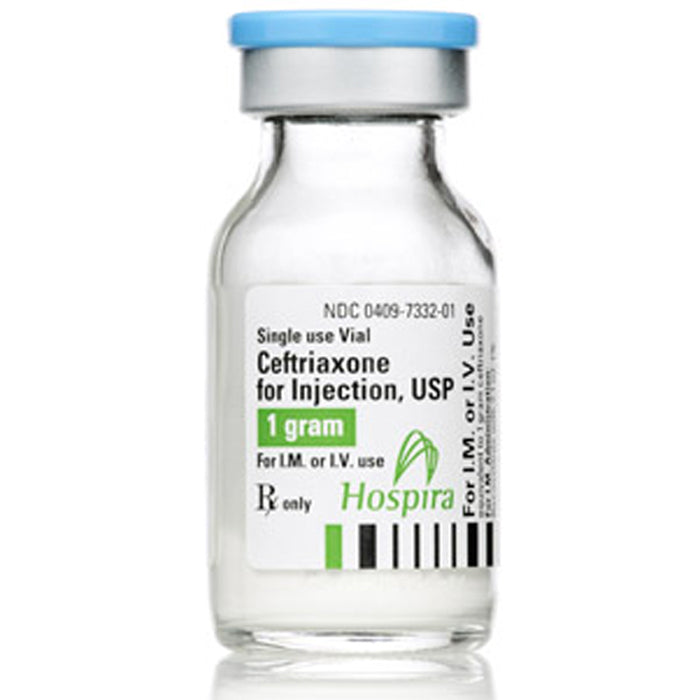Ceftriaxone Sodium Injection 250 mg 1 mL Vials, 10 Pack by Pfizer (Rx)
How to Order:
You will receive instructions on how to create an account along with Rx Ordering Details.
(Note: Acceptable licenses must have Prescriptive Authority in the license issuing state.)
Ceftriaxone Sodium Injection 250 mg 1 mL Vials are used to treat a variety of bacterial infections. As a broad-spectrum cephalosporin antibiotic, it works by inhibiting cell wall synthesis, effectively killing bacteria. It is often utilized for infections such as respiratory tract infections, urinary tract infections, skin infections, and sexually transmitted infections like gonorrhea. This injection provides a rapid therapeutic response, is administered intravenously or intramuscularly, and is crucial in managing severe and systemic bacterial infections.
Ceftriaxone Sodium for Injection is a sterile, broad-spectrum cephalosporin antibiotic used for the treatment of various bacterial infections. This formulation by Pfizer Injectables contains 250 mg of ceftriaxone sodium per 1 mL vial and is packaged in packs of 10 vials. It is designed for intravenous (IV) or intramuscular (IM) administration, and it is effective against a wide range of Gram-positive and Gram-negative bacteria.
Details and Features:
Dosage Form: 250 mg of ceftriaxone per 1 mL vial
Packaging: 10 vials per pack
Administration Routes: Intravenous (IV) or intramuscular (IM)
Spectrum: Broad-spectrum antibiotic effective against various bacteria, including respiratory system, urinary tract, skin, and other types of infections
Use: Commonly used to treat infections such as bacterial meningitis, pneumonia, sepsis, and gonorrhea
Mechanism of Action:
Ceftriaxone, a third-generation cephalosporin antibiotic, works by inhibiting bacterial cell wall synthesis. It binds to penicillin-binding proteins (PBPs) inside the bacterial cell wall, disrupting the cross-linking of peptidoglycan layers, which are essential for cell wall structural integrity and maintenance. This disruption leads to cell wall breakdown and eventual cell lysis, effectively killing the bacteria.
Warnings:
-
Hypersensitivity: Contraindicated in patients with known allergy to ceftriaxone, cephalosporins, or any of the excipients. Use with caution in those with a history of penicillin allergies due to possible cross-reactivity.
-
Neonatal Risk: Not recommended for use in neonates with hyperbilirubinemia due to risk of bilirubin encephalopathy.
-
Calcium Interaction: Avoid mixing with calcium-containing solutions due to the risk of precipitation, which can cause serious adverse effects.
-
Gastrointestinal Effects: Potential development of Clostridium difficile-associated diarrhea (CDAD), ranging from mild diarrhea to fatal colitis.
- Renal and Hepatic Impairment: Dose adjustments may be needed for patients with significant renal or hepatic dysfunction.
Side Effects:
Potential side effects of Ceftriaxone Sodium for Injection include:
-
Local Reactions: Pain, redness, or swelling at the injection site.
-
Gastrointestinal: Diarrhea, nausea, vomiting, stomach cramps. In some cases, pseudomembranous colitis due to C. difficile can occur.
-
Hematologic: Eosinophilia, thrombocytosis, or leukopenia.
-
Liver Function: Transient changes in liver enzymes.
- Hypersensitivity Reactions: Rash, pruritus, or more severe reactions such as
-
Stevens-Johnson syndrome. Anaphylaxis is rare but possible.
- Renal and others: Possible renal function changes and the formation of gallbladder sludge.
Ceftriaxone should be administered by healthcare professionals with consideration to appropriate dosing guidelines and patient-specific factors to ensure safety and effectiveness. Regular monitoring for adverse reactions, especially in patients with renal or hepatic concerns, should be performed.



